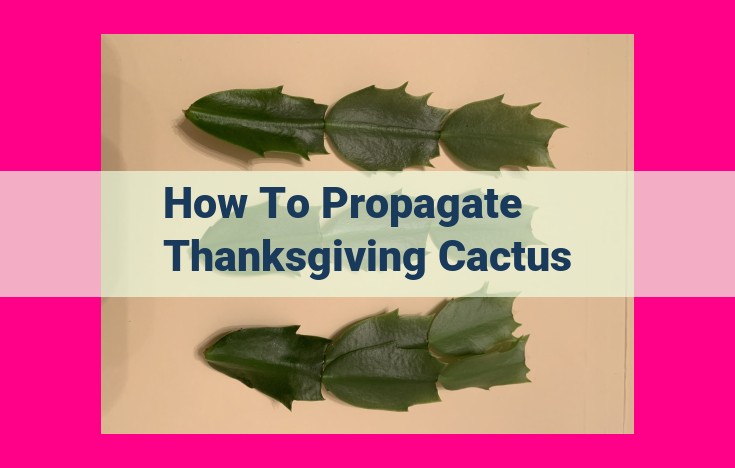Easy Thanksgiving Cactus Propagation: Stem And Leaf Cuttings Guide

Propagate Thanksgiving cactus by taking stem cuttings or leaf cuttings. Use a sharp knife to take cuttings from a healthy plant, ensuring each cutting has at least 2-3 segments. Allow cuttings to dry for a day before planting in moist potting mix. Provide adequate light and humidity, and maintain a warm temperature for optimal rooting.
Propagating Thanksgiving Cactus: A Step-by-Step Guide
Materials: The Essential Tools
To embark on the magical journey of propagating your beloved Thanksgiving cactus, assemble the following tools and supplies. They’re the secret ingredients that will nurture your cuttings into thriving new plants.
First, procure a sharp knife to make precise cuts that promote healthy root development. Next, choose a potting mix specifically formulated for cacti and succulents, ensuring drainage and aeration for optimal growth. Opt for pots or trays with drainage holes to prevent waterlogging.
Enlist the aid of a rooting hormone to give your cuttings a boost of rooting power. Finally, keep a spray bottle filled with water at hand to maintain the ideal humidity levels.
With these tools in your possession, you’re ready to delve into the enchanting world of Thanksgiving cactus propagation. Let’s explore the different methods to nurture these vibrant plants and bring more joy to your home!
Plant Material: Embarking on the Propagation Journey
When it comes to propagating Thanksgiving cactus (Schlumbergera truncata), two distinct methods emerge: stem cuttings and leaf cuttings. Each technique unveils its own set of intricacies, but both offer a rewarding path to nurturing new life.
Stem Cuttings: A Time-Tested Approach
The art of stem cuttings is a time-honored practice that entails carefully selecting and preparing mature segments of the stem. Using a sharp, sterile knife, make a clean cut just below a leaf node. The resulting cutting should be approximately 3-4 inches in length, adorned with multiple leaf segments. Remove the bottom leaf segments to expose the stem’s base.
Leaf Cuttings: A Novel Adventure
Leaf cuttings, an innovative approach, involve detaching single leaf segments from the Thanksgiving cactus. Ensure that the leaf segments are healthy and plump, exhibiting a vibrant green hue. Remove any small offsets or protrusions from the leaf base to facilitate rooting.
Note: Before embarking on either propagation technique, consider treating the cuttings with a rooting hormone. This magical elixir stimulates root development, expediting the journey towards successful establishment.
Environmental Conditions: The Key to Successful Propagation
To enhance the rooting process and increase your chances of success, it’s crucial to optimize the environmental conditions for your Thanksgiving cactus cuttings. Three key factors to consider are temperature, humidity, and light.
Temperature
Thanksgiving cactus thrives in warm temperatures between 65°F (18°C) and 75°F (24°C). Maintaining this ideal range is essential for root development. Avoid exposing the cuttings to temperatures below 60°F (16°C) or above 85°F (29°C), as this can hinder rooting.
Humidity
Humidity plays a vital role in promoting root growth. High humidity levels create a moist environment that encourages the formation of new roots. You can increase humidity by placing the cuttings in a closed container or by misting them regularly with a spray bottle.
Light
While Thanksgiving cactus prefers bright, indirect light, it’s important to avoid placing it in direct sunlight, especially during the summer months. Bright, filtered light is optimal for promoting healthy root development.
Related Entities: The Thanksgiving Cactus Family
Embrace the enchanting world of the Thanksgiving cactus and discover its captivating connections to the plant kingdom. This resilient succulent shares a remarkable lineage with its festive counterparts, offering a glimpse into the diversity of the plant family.
Christmas Cactus vs. Thanksgiving Cactus: A Tale of Two Holiday Blooms
The Christmas cactus, Schlumbergera bridgesii, and Thanksgiving cactus, Schlumbergera truncata, are sibling species renowned for their vibrant holiday blooms. While sharing similar appearances, they possess subtle distinctions:
- Thanksgiving cactus: Adorns its segments with serrated edges and shorter, wider blooms primarily in shades of pink, orange, and yellow.
- Christmas cactus: Boasts smooth segment edges and elongated blooms in red, white, and purple.
Easter Cactus: The Festive Trio’s Enigmatic Member
The Easter cactus, Rhipsalidopsis gaertneri, completes the trio of holiday cacti. This enigmatic species stands apart with:
- Flattened segments with rounded edges
- Tubular flowers in an array of pastel shades
- Late spring or summer blooming period
Succulents and Cacti: A Bond of Thirst and Resilience
The Thanksgiving cactus finds its home among the vast family of succulents and cacti, united by their extraordinary ability to thrive in arid environments. These plants conserve water in their:
- Thick, fleshy leaves or stems
- Waxy cuticle that minimizes water loss
Embark on a journey through the fascinating connections of the Thanksgiving cactus family, appreciating their unique traits and shared heritage.